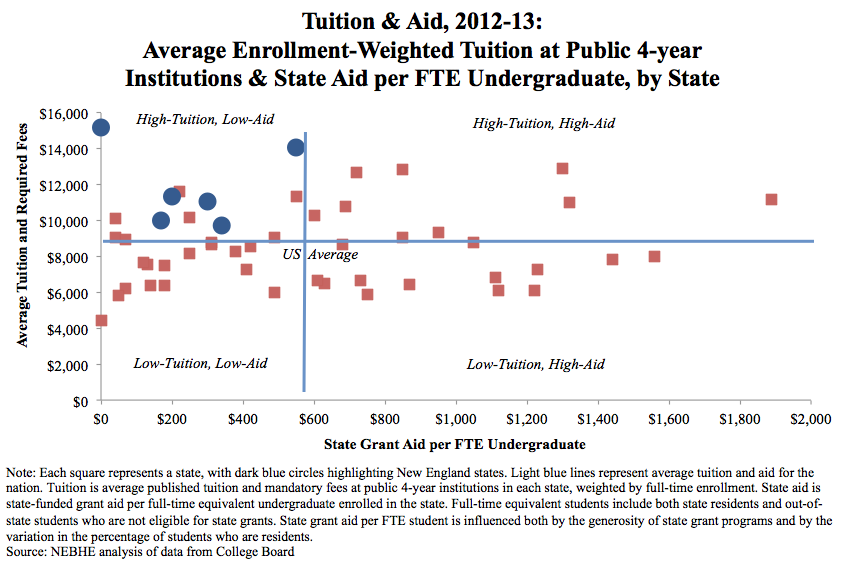College affordability is an increasingly important public policy issue. With decision-making power over funding to institutions, funding to students and the pricing of institutions, states play a tremendous role in determining what students pay for college. In New England, these decisions are spread across institutional boards, system offices, state agencies and state legislatures. The processes for making these decisions is relatively decentralized compared with the rest of the country. Because the region also has high tuition rates and low state grant aid levels compared with the nation, the need for policymakers to convene around these decisions across boards and governance structures is amplified.
Conversations on paying for college are happening at dinner tables and in state legislatures across New England everyday—so this a timely opportunity for state players to collaborate on these policy decisions and shape a more cohesive strategy for impacting college affordability in the region.
Click chart to enlarge.
To address affordability, some states pursue a high-tuition high-aid model: Tuition rates and state grant aid awards are higher than average, allowing higher-income students to pay high tuition while providing an opportunity for lower-income students to pay that tuition using state financial aid. Alternatively, some states employ a low-tuition low-aid model, whereby both tuition rates and state grant aid levels are low, thereby lowering the cost of education to all students. The New England states, represented by blue circles in the above figure, might be described as high-tuition low-aid—a threat to college affordability in the region.
One of the ways states align tuition and aid strategies is to centralize the decision-making process or authority for each of these policies. For example, while governors and state legislatures appropriate funds to institutions and state financial aid agencies through the state’s budget, they also sometimes set tuition levels and parameters for using tuition revenue toward institutional aid—or at least play an informal or consultative role in the tuition-setting process.
Many states ask institutions to submit tuition rate proposals that are in line with guidance from the state legislature, according to the State Higher Education Executive Officers Association (SHEEO). When setting appropriations to financial aid agencies and setting the level of tuition are the responsibility of the same branch of state government, these decisions are made at least in the same room, if not necessarily in the same conversation.
This process is more decentralized for most of New England, as found by NEBHE’s recent survey of institutions and systems boards. Typically, the governor and state legislature decide how much state funding to appropriate to public institutions and student financial aid, while a separate system governing or coordinating board decides at what level to set tuition and fees. Further, some individual institutions set their own required fees and most offer institutional grant aid to students. In many sectors and systems in the region, the governor and legislature have no role in the tuition-setting process. The freedom and flexibility afforded by this decentralization may mean that conversations about aligning tuition and aid strategies happen in several different places at several different times.
This decentralization calls for a greater need to convene and collaborate in New England states than in other states across the nation. Having key leaders—state legislators, state financial aid agency representatives, system heads, and institutional presidents, among others—sit at the same table when discussing tuition and aid decisions may improve the process without any change to structure or authority.
As New England states work to increase the share of residents with high-quality postsecondary credentials, state funding strategies play a critical role in maintaining access to and the affordability of public institutions. In fact, Connecticut’s recently developed strategic master plan for higher education cites these policies and procedures as “the strongest tools available to state governments as they seek to not only create an appropriate array of strong institutions but to ensure that these institutional assets are deployed in ways that serve the priority needs of the state.”
With state policymakers passionately discussing college affordability in the context of all-encompassing master plans like Connecticut’s all the way down to the year-to-year awards of state need-based grant programs, New England has a bright opportunity to convene decision-makers and protocols around a common goal. Institutional appropriations, student aid and the level of tuition and mandatory fees are all powerful instruments at a state’s disposal: When aligned in a strategic, intentional way, they can exert a powerful impact on college affordability for the region.
Gretchen Syverud is a policy research analyst at NEBHE.
[ssba]

